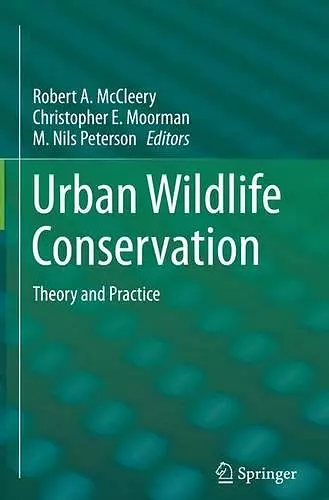Urban Wildlife Conservation
Theory and Practice
M Nils Peterson editor Robert A McCleery editor Christopher E Moorman editor
Format:Hardback
Publisher:Springer-Verlag New York Inc.
Published:11th Nov '14
Currently unavailable, and unfortunately no date known when it will be back

In the past, wildlife living in urban areas were ignored by wildlife professionals and urban planners because cities were perceived as places for people and not for wild animals. Paradoxically, though, many species of wildlife thrive in these built environments. Interactions between humans and wildlife are more frequent in urban areas than any other place on earth and these interactions impact human health, safety and welfare in both positive and negative ways. Although urban wildlife control pest species, pollinate plants and are fun to watch, they also damage property, spread disease and even attack people and pets. In urban areas, the combination of dense human populations, buildings, impermeable surfaces, introduced vegetation, and high concentrations of food, water and pollution alter wildlife populations and communities in ways unseen in more natural environments. For these ecological and practical reasons, researchers and mangers have shown a growing interest in urban wildlife ecology and management.
This growing interest in urban wildlife has inspired many studies on the subject that have yet to be synthesized in a cohesive narrative. Urban Wildlife: Theory and Practice fills this void by synthesizing the latest ecological and social knowledge in the subject area into an interdisciplinary and practical text. This volume provides a foundation for the future growth and understanding of urban wildlife ecology and management by:
• Clearly defining th
e concepts used to study and describe urban wildlife,• Offering a cohesive understanding of the coupled natural and social drivers that shape urban wildlife ecology,
• Presenting the patterns and processes of wildlife response to an urbanizing world and explaining the mechanisms behind them and
• Proposing means to create physical and social environments that are mutually beneficial for both humans and wildlife.
“This book compiles some 30 years of literature on wildlife in urban areas, including such aspects as the impacts of dense human populations, buildings, and concentrations of food and water. It also considers the social, economic, and political factors relevant to interactions between wildlife and humans. … This valuable, informative book should be on the reference shelves of wildlife biologists and urban planners as well as students in these areas. Summing Up: Recommended. Upper-division undergraduates through professionals/practitioners.” (R. L. Smith, Choice, Vol. 52 (11), July, 2015)
ISBN: 9781489974990
Dimensions: unknown
Weight: 7509g
406 pages
2014 ed.